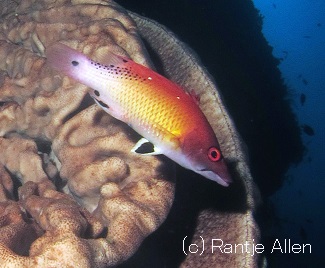Loading content - please wait...
Bodianus dictynna thrives in Gorontalo
Bodianus dictynna is commonly found in Gorontalo’s coral rich reefs. This species was scientifically described in 2006. Since it is only found in the Pacific Ocean, the common name is Pacific Diana hogfish.
One Goddess, Two Species
For decades, divers and fish enthusiasts thought that there was only a single species of Diana hogfish. However, based on Dr. Martin F. Gomon’s extensive research, populations were separated in 2006. The Diana hogfish in the Indian Ocean remain Bodianus diana, whereas the newly named Bodianus dictynna lives in the Pacific Ocean. Both are very similar in appearance. So
, the best way to recognize the species is simply by location.Both Latin word diana and dictynna refer to the Roman goddess Diana. She was the moon goddess and famous huntress. The genus name Bodianus comes from a Portuguese word that means modesty. As a result of Gomon’s research
, scientists now recognize 45 species of Bodianus. These are found in the Atlantic, Indian, and Pacific oceans.Bodianus dictynna in Gorontalo
The Pacific Diana hogfish lives in warm
, tropical waters. It lives as far north and south as Japan and Australia. Its eastern boundary is Tonga. No one knows yet how the recent volcanic explosion there will affect fish life. For unknown reasons , this hogfish species is rare in the central Pacific plate.As to habitat, Bodianus dictynna prefers coral reefs. Juveniles frequent black corals and gorgonians. The juveniles also like the ceilings of underwater caverns. So
, Gorontalo’s Jinn Caves dive site is a great place to search for this fish.Divers should note that juveniles have a color pattern distinct from adults. Juveniles have a maroon and white maze pattern with distinctive black spots. These spots are on both ventral and dorsal fins as well as on the tail’s end. A terminal phase male sports a large black spot on the end of his dorsal fin. Also, he will have a black spot on mid anal and pelvic fins.
Adults eat molluscs and crustaceans. Juveniles eat parasites off the skin of other fish. Adults mate in pairs.
For your chance to see a Pacific Diana hogfish in Gorontalo, please make your dive reservations directly with Miguel’s Diving.






